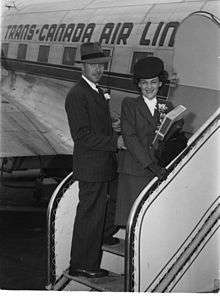Honeymoon
A honeymoon is a holiday taken by newlyweds immediately after their wedding, to celebrate their marriage. Today, honeymoons are often celebrated in destinations considered exotic or romantic.
History


In Western culture and some westernized countries’ cultures, the custom of a newlywed couple's going on a holiday together originated in early-19th-century Great Britain. Upper-class couples would take a "bridal tour", sometimes accompanied by friends or family, to visit relatives who had not been able to attend the wedding.[1] The practice soon spread to the European continent and was known in France as a voyage à la façon anglaise (translation: English-style voyage), from the 1820s onwards.
Honeymoons in the modern sense—a pure holiday voyage undertaken by the couple—became widespread during the Belle Époque,[2] as one of the first instances of modern mass tourism. This came about despite initial disapproval by contemporary medical opinion (which worried about women's frail health) and by savoir vivre guidebooks (which referred to the public attention drawn to what was assumed to be the wife's sexual initiation). The most popular honeymoon destinations at the time were the French Riviera and Italy, particularly its seaside resorts and romantic cities such as Rome, Verona, and Venice. Typically honeymoons would start on the night of the marriage, with the couple leaving midway through the reception to catch a late train or ship. However, in the 21st century, many couples will not leave until 1–3 days after the ceremony and reception.[3] In Jewish traditions, honeymoons are often put off seven days to allow for the seven nights of feasting if the visits to friends and family cannot be incorporated into the trip.
Etymology
The honeymoon was originally the period following marriage, "characterized by love and happiness", as attested since 1546.[4] The word may allude to "the idea that the first month of marriage is the sweetest".[5]
According to a different version of the Oxford English Dictionary:
The first month after marriage, when there is nothing but tenderness and pleasure (Samuel Johnson); originally having no reference to the period of a month, but comparing the mutual affection of newly married persons to the changing moon which is no sooner full than it begins to wane; now, usually, the holiday spent together by a newly married couple, before settling down at home.
Today, honeymoon has a positive meaning, but originally it may have referred to the inevitable waning of love like a phase of the moon. In 1552, Richard Huloet wrote:
Hony mone, a term proverbially applied to such as be newly married, which will not fall out at the first, but th'one loveth the other at the beginning exceedingly, the likelihood of their exceadinge love appearing to aswage, ye which time the vulgar people call the hony mone.
— Abcedarium Anglico-Latinum pro Tyrunculis[4]
A fanciful 19th-century theory claimed that the word alludes to "the custom of the higher order of the Teutones... to drink Mead, or Metheglin, a beverage made with honey, for thirty days after every wedding",[6][7] but the theory is now rejected.[8][9]
In many modern languages, the word for a honeymoon is a calque (e.g., French: lune de miel) or near-calque.
One possible source of the word is from Persian mah-e-asal, which translates to "month of honey".[10] The Persian word mah means both "moon" and "month", just as the English word "month" derives from "moon", and the kanji used in Japanese is the same for both "moon" and "month".[11] This is likely a result of most ancient calendars being lunar calendars, where a month is defined as one lunar cycle.[12]
Another practical source for the term comes from the early days in the life of a honey bee queen. Immediately after her birth within a hive, a queen bee leaves the hive over the course of several days, to meet up with multiple drones in separate drone congregation areas. She is inseminated with a lifetime of sperm, and then returns to the hive to remain there the rest of her life, laying eggs. The queen essentially goes away for a "honey-moon" and returns, ready to live the rest of her life. The centuries-old practice of beekeeping may have led to other folklore related to this "going away" before starting a life "in the hive" (back at home).
Effects
One 2015 scholarly study concluded that going on a honeymoon is associated with a somewhat lower risk of divorce, regardless of how much or little is spent on the honeymoon itself.[13] However, high spending and incurring significant debt on other wedding-related expenses, such as engagement rings and wedding ceremonies, is associated with a high risk of divorce.[13]
Solomoon or unimoon
An emerging 21st-century travel trend is the "solomoon" or "unimoon", a separate, solo holiday the newlyweds take without their spouse.[14][15] The New Zealand Herald cites a report by The New York Times[16] that such alternatives to honeymoons are "particularly suited for couples who just cannot agree on where to go".[17] (This trend contrasts with the use by a jilted bride or groom of the travel reservations intended for the honeymoon, as popularly depicted in such films as Sex and the City: The Movie (2008), wherein Carrie Bradshaw turns her ruined Mexican honeymoon into a girls' trip,[18] and Like Father (2018), wherein a bride left at the altar travels with her absentee father on the cruise meant for her honeymoon.[19])
See also
- Marriage leave
- Vacation
- List of Honeymoon Destinations by Country
References
- Strand, Ginger (January 2008). "Selling Sex in Honeymoon Heaven". The Believer.
- Venayre, Sylvain (June 2007). "Le Temps du voyage noces". L'Histoire (321): 57. ISSN 0182-2411.
- Goodwell, Sally. "Honeymoon Statistics" (PDF). HoneymoonGoals.com. Retrieved 19 December 2019.
- "Honeymoon". Oxford English Dictionary. s.v.
- "Honeymoon". Merriam-Webster Dictionary. s.v.
- Pulleyn, William (1853). The Etymological Compendium. p. 178.
- Brewer, Ebenezer Cobham (c. 1870). Dictionary of Phrase and Fable (4th ed.). p. 413.
- Brohaugh, Bill (2008). Everything you know about English is wrong. Naperville, Ill.: Sourcebooks. p. 92. ISBN 9781402211355.
- Monger, George P. (2013). Marriage customs of the world: An encyclopedia of dating customs and wedding traditions (Expanded 2nd ed.). Santa Barbara, CA: ABC-CLIO. p. 352. ISBN 9781598846645. Retrieved 1 October 2014.
- url="https://www.imdb.com/title/tt1104084/"
- url="https://en.wiktionary.org/wiki/%E6%9C%88"
- url="https://www.britannica.com/science/lunar-calendar"
- Francis-Tan, Andrew; Mialon, Hugo M. (2014-09-15). "'A Diamond is Forever' and Other Fairy Tales: The Relationship between Wedding Expenses and Marriage Duration". Rochester, NY. doi:10.2139/ssrn.2501480. SSRN 2501480. Cite journal requires
|journal=(help) - Leasca, Stacey (15 March 2019). "The 'unimoon' — a honeymoon without your new spouse — is a 'travel trend' we just can't get behind". Travel & Leisure.
- Laneri, Raquel (March 14, 2019). "Newlyweds are now going on separate honeymoons". New York Post.
- Braff, Danielle Braff (March 13, 2019). "Until Honeymoon We Do Part". The New York Times.
- "The rise of the 'unimoon': People are going on honeymoons without their spouses". New Zealand Herald. 16 March 2019.
- Arneson, Krystin (September 16, 2017). "This Is the Perturbing Reason Carrie Wound Up With Big in 'Sex and the City'". Glamour.
- Czachor, Emily Mae (June 18, 2018). "Netflix's 'Like Father' Trailer Sends Kristen Bell On A Traumatizing Honeymoon". Bustle.